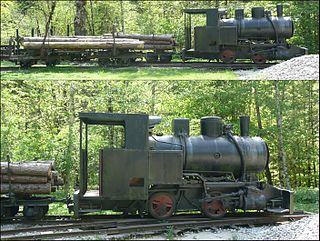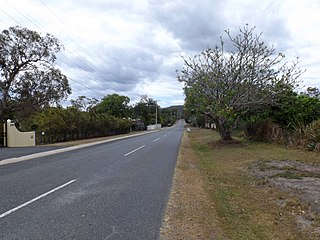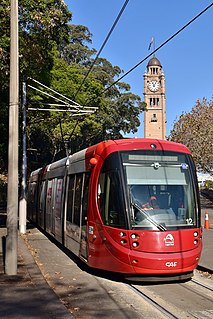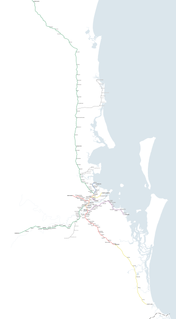
Norman Park railway station is located on the Cleveland line in Queensland, Australia. It serves the Brisbane suburb of Norman Park.

The Camp Mountain rail accident occurred at approximately 9:48am on 5 May 1947 when a crowded picnic train derailed on a sharp left-hand curve between Ferny Grove and Camp Mountain stations on the now-closed Dayboro line, approximately 15 km (9.3 mi) northwest of Brisbane, the state capital of Queensland, Australia.

Windsor is an inner northern suburb of Brisbane, Queensland, Australia, located about 3.5 kilometres (2.2 mi) from the Brisbane central business district. It is largely residential, featuring many old Queenslanders, although there is also considerable retail commercial activity, primarily concentrated along Lutwyche and Newmarket Roads.

Carina is a suburb of Brisbane, Australia. It is located 7 kilometres (4.3 mi) east of the CBD, and borders Carindale, Carina Heights, Cannon Hill and Camp Hill.

Woolloongabba is a suburb of Brisbane, Australia. It is located 2 kilometres (1.2 mi) south-east of the CBD, and contains the Brisbane Cricket Ground and the Princess Alexandra Hospital. It is crossed by several major roads including the Pacific Motorway. The suburb was once home to a large tram depot.

Camp Hill is an eastern suburb in the City of Brisbane, Queensland, Australia. In the 2016 census, Camp Hill had a population of 11,202 people.

Seven Hills is a suburb of Brisbane, Queensland, Australia. It is located 5 kilometres (3.1 mi) east of the CBD, and borders Camp Hill, Carina, Morningside, and Norman Park.

The North Coast railway line is a narrow gauge railway line in Queensland, Australia. It commences at Roma Street station, Brisbane, and largely parallels the Queensland coast to Cairns in Far North Queensland. The line is electrified between Brisbane and Rockhampton. Along the way, the 1680 km railway passes through the numerous towns and cities of eastern Queensland including Nambour, Bundaberg, Gladstone, Rockhampton, Mackay and Townsville. The line though the centre of Rockhampton runs down the middle of Denison Street.

Norman Park is a suburb of Brisbane, Queensland, Australia, located 4 kilometres (2.5 mi) east of the CBD. It borders East Brisbane, Coorparoo, Camp Hill, Morningside and Hawthorne, and is mostly residential.

Tramways are lightly laid railways, sometimes with the wagons or carriages moved without locomotives. Since individual tramway cars are not intended to carry the weight of typical standard-gauge railway equipment, the tramways over which they operate may be built of less substantial materials. Tramways can take many forms; sometimes just tracks temporarily placed on the ground to transport materials around a factory, mine or quarry. Many, if not most, are narrow-gauge railway technologies. Motive power to move the trains can be manually pushed by hand, pulled by animals, cable hauled by a stationary engine, or use small locomotives. At the other extreme they could be complex and lengthy systems, such as the Lee Moor Tramway in the county of Devon, England, in the United Kingdom.

The Queensland rail network, the first in the world to adopt 1,067 mm narrow gauge for a main line, and now the second largest narrow gauge network in the world, consists of:

Transport in Brisbane, the capital and largest city of Queensland, Australia, is provided by road, rail, river and bay ferries, footpaths, bikepaths, sea and air.

The Brisbane tramway network served the city of Brisbane, Australia, between 1885 and 1969. It ran on standard gauge track. The electric system was originally energised to 500 volts, and subsequently increased to 600 volts. All tramcars built in Brisbane up to 1938 had an open design. This proved so popular, especially on hot summer nights, that the trams were used as fundraisers and often chartered right up until the last service by social groups.

Belmont is an outer suburb of the City of Brisbane, Queensland, Australia. It is 12 kilometres (7.5 mi) south-east of the Brisbane CBD.

The earliest trams in Australia operated in the latter decades of the 19th century, hauled by horses or "steam tram motors". At the turn of the 20th century, propulsion almost universally turned to electrification, although cable trams lingered in Melbourne. In cities and towns that had trams, they were a major part of public transport assets.

Queensland Rail operates ten suburban lines and three interurban lines. Centring in the Brisbane City, it extends as far as Gympie in the north, Varsity Lakes in the south, Rosewood in the west, and Cleveland in the east to Moreton Bay.

Old Cleveland Road is a major road in Brisbane, Queensland. It runs 19.3 kilometres (12.0 mi) from Stones Corner to Capalaba in Brisbane, with most of the route signed as State Route 22. Sections of the road are also part of State Routes 30, 54, and 55. The road is the main route from inner Brisbane to Capalaba and Cleveland since New Cleveland Road only links Tingalpa with Capalaba.

The Beaudesert Shire Tramway was a narrow gauge tramway which operated from Beaudesert to Lamington and Rathdowney in Queensland. It was one of 15 light railways built and operated by Divisional Boards and Shire Councils in Queensland. The line carried passengers and cargo. It operated from 1903 to 1944. It was initially profitable and seen as a great success for the local shire council. The tramway is credited with opening up the agricultural lands of the upper Logan River.

Old Cleveland Road Tramway Tracks is a heritage-listed tramway at Old Cleveland Road, Carina, City of Brisbane, Queensland, Australia. It was built in 1948 by Brisbane City Council. It is also known as Belmont Electric Tramway. It was added to the Queensland Heritage Register on 24 March 2000.
Rockhampton Council Tramways was a steam tram service which was operated by Rockhampton City Council from 1909 until 1939 in the Central Queensland city of Rockhampton, the only regional city in Queensland to have had a tram service. The line has since been rebuilt and is operated as a tourist attraction by the Archer Park Rail Museum.



















